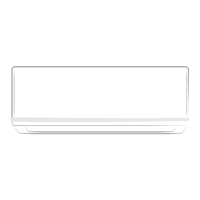Page 26mrcool.com
Refrigerant Piping Connection
Outer Diameter
of Pipe (in/mm)
Tightening Torque
(lb·ft/N·m)
Flare Dimension (B)
(in/mm)
Flare Shape
Ø0.25” (Ø 6.35 mm)
13.28-14.75 lb•ft (18-20 N·m)
0.33”-0.34” (8.4-8.7 mm)
Ø0.375” (Ø 9.52 mm)
23.60-28.76 lb•ft (32-39 N·m)
0.52”-0.53” (13.2-13.5 mm)
Ø0.5” (Ø12.7 mm)
36.14-43.52 lb•ft (49-59 N·m)
0.64”-0.65” (16.2-16.5 mm)
Ø0.63” (Ø16 mm) 42.04-52.37 lb•ft (57-71 N·m) 0.76”-0.78” (19.2-19.7 mm)
Ø0.75” (Ø19 mm) 49.42-74.49 lb•ft (67-101 N·m) 0.91”-0.93” (23.2-23.7 mm)
≥4 in (10 cm)Radius
Fig. 6.6
When bending refrigerant piping, the minimum bending radius is 10 cm. See Fig 6.6.
MINIMUM BEND RADIUS
TORQUE REQUIREMENTS
1. Excessive force can break the nut or damage the refrigerant piping. You must not
exceed torque requirements shown in the table below.
2. You can find the Outer Pipe Diameter stamped (in inches) on the valve set of the
condenser. Refer to this when finding and applying the torque values in the table
below.
3. Note that there may be differences in Torque Wrenches (i.e. automotive torque
wrench versus a HVAC torque wrench) and that a socket style wrench cannot be used
here.
Step 3: Flare pipe ends continued
6. Place flaring tool onto the form.
7. Turn the handle of the flaring tool clockwise
until the pipe is fully flared.
8. Remove the flaring tool and flare form, then
inspect the end of the pipe for cracks and even
flaring.
Step 4: Connect pipes
When connecting refrigerant pipes, be careful not to use excessive torque or to deform the piping in
any way. You should first connect the low-pressure pipe, then the high-pressure pipe.
R0.4~0.8
45°±2
90°±4
B
TORQUE REQUIREMENTS TABLE

